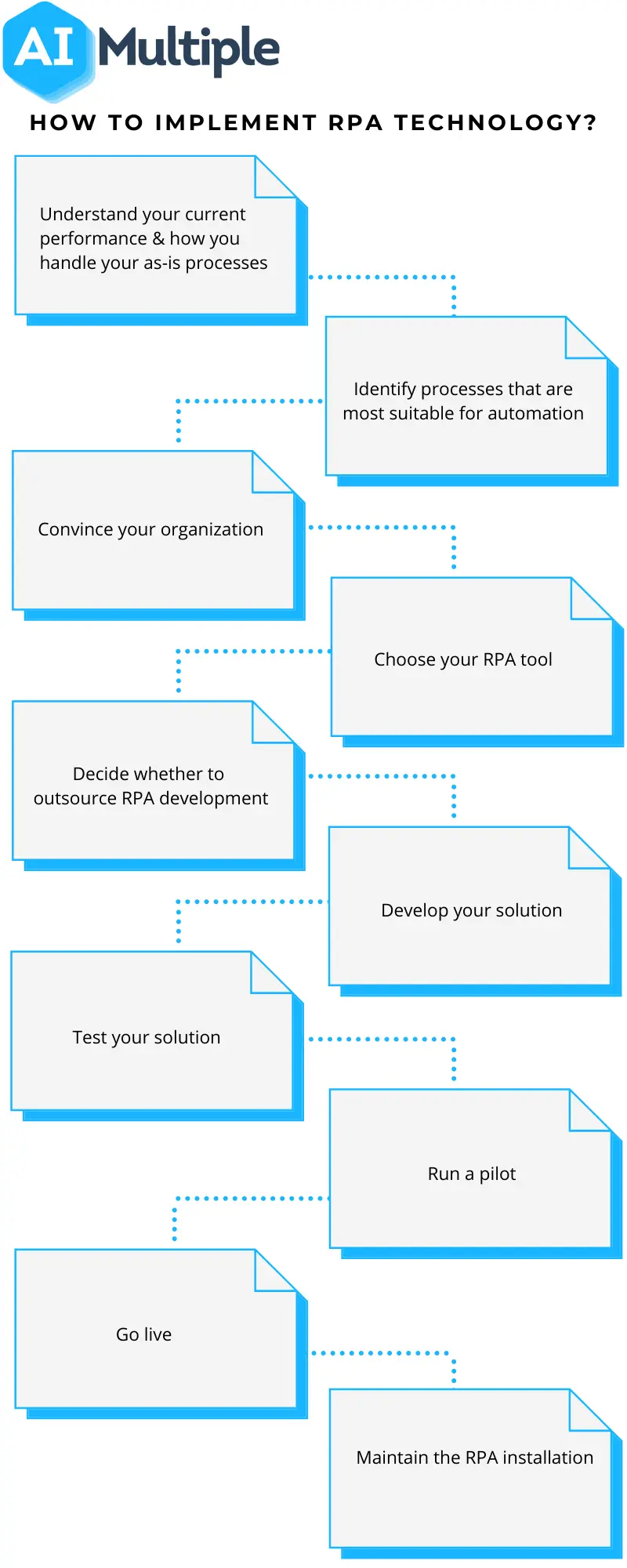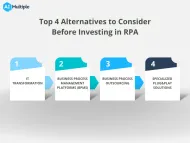Tech & Skills Required for RPA Success in 2024: In-depth Guide
RPA is a trending technology that helps businesses achieve more efficient processes. While it applies to many business processes from finance to human resources, it is critical to identify the most suitable processes for automation to maximize RPA benefits. Businesses leverage other technologies, like process mining and data extraction, along with the necessary skills for RPA deployment like strategic planning, process understanding as well as programming skills.

What is RPA?
Robotic Process Automation (RPA) is a growing automation technology to perform high-volume, rule-based, and repetitive processes faster and with fewer errors. As most of these RPA tasks include form-filling, copy-pasting, and systems-integrating, RPA bots allow humans to focus on higher value-adding tasks. Below are some examples:
- Invoice processing: Automated extraction of data from invoices, validation and recording them
- Loan processing: Automated document extraction from related documents and automated loan decisions
- CV screening: Automated CV assessment of candidates and interviewing using bots
For more RPA applications, feel free to visit our in-depth RPA use cases guide.
To learn more, you can read more about this in our related RPA article.
Which processes can be integrated into RPA technologies?
It is critical to choose the most suitable processes for automation to maximize the benefits of RPA. Failure to do that might result in lower ROI since a high level of automation may not be achieved with RPA in processes that are not good candidates to be automated. Here are some characteristics of the best processes for automation to maximize the impact of RPA:
- Impacting both cost and revenues in finance
- High volume tasks
- Fault-tolerant
- Error-prone
- Speed-sensitive
- Requiring irregular labor
Choosing processes that are easier and faster to automate with RPA can save costs and provide a more straightforward implementation. Those processes tend to be:
- Rules-based
- With fewer exceptions
- Company-specific
- Stable
- Not on the roadmap for new systems
Automation of processes that fit the above characteristics will provide the maximum impact for your business and an easier RPA implementation process. You can read more about these characteristics in the related part of our RPA guide.
How to implement RPA technology?
Here is a short step-by-step explanation of how to implement RPA in your business.
- Understand your current performance and how you handle your as-is processes
- Identify processes that are most suitable for automation
- Convince your organization
- Choose your RPA tool
- Decide whether to outsource RPA development
- Develop your solution
- Test your solution
- Run a pilot
- Go live
- Maintain the RPA installation
You can read more details on this in our RPA implementation guide
To successfully leverage RPA technology to automate your business, check out our lists of:
And if you are working as an RPA consultant, to learn about how you can pick a cost-effective RPA technology partner, download our RPA whitepaper:
Which technologies to use with RPA?
AI & Machine Learning
The main limitation of RPA is the lack of cognitive ability. RPA tools cannot learn from their previous experience or perform tasks that require judgment. The technology can continuously handle repetitive processes in a predefined way. To overcome this limitation, introducing machine learning algorithms or other forms of AI can be a powerful solution.
RPAAI, also called cognitive automation or intelligent RPA (IPA), is RPA powered by AI technologies. This is an emerging technology and these RPA bots aim to manage tasks requiring judgment without manual intervention. These bots can understand specific patterns within tasks and automate them according to those patterns.
Process Mining
Process mining technology enables businesses to fully understand the actual conditions of processes. It uses real-time performance measures and event logs to identify bottlenecks and present factual insights. By using process mining technology, businesses can:
- Prioritize the best processes for automation
- Implement RPA initiatives faster, as the business logic of processes is perceived
- Monitor RPA bots’ performance and measure their benefits
Considering the increasing amount of data, today’s processes become more complicated and harder to fully understand. While most of the data remains unused, process mining technology can leverage this unused data to give better insights about the actual conditions of processes. If you want to read more, feel free to read our RPA deployment with process mining guide.
Data Extraction
Data extraction technologies help businesses convert unstructured or semi-structured data into structured data. While manually extracting data from different sources can be tiring and prone to errors, RPA can automate this process, save costs, and allow employees to work on higher value-adding activities.
You can learn more about data extraction technologies in our in-depth guide and our data-driven list of data extraction tools.
What are the relevant skills to build your RPA solution?
To understand how to deploy new RPA projects for companies, RPA developers need to know how RPA technology works and have specific skills to build successful RPA solutions. We can group these skill sets into two main categories:
Technical Skills
Understanding of programming languages/frameworks
A certain level of programming knowledge is necessary to develop new RPA bots. It is essential to build custom RPA solutions for businesses because:
- They are required for complex processes
- RPA marketplaces allow developers and companies to monetize their custom-built RPA solutions
Although RPA developers can use any language of their choice to build their solutions, this would be a more time-consuming way than leveraging other RPA vendors’ frameworks. Today, most vendors use .Net Framework to build RPA solutions.
However, some vendors offer Java or Python options, as well. Python is the 3rd most popular programming language on Github and is among the fastest-growing languages in terms of popularity. Thus, Python would be a more sustainable option if you want to improve programming skills in understanding a programming language.
Sponsored:
For companies that don’t have employees with a high level of programming knowledge, there are also low-code RPA solutions, like Argos Labs, emerging in the market. These low-code solutions require less knowledge of programming languages and help companies build customized RPA solutions thanks to their user-friendly interface.
Debugging skills
Besides developing a new RPA solution, it is also vital to monitor its performance and correct any possible errors. RPA developers need to test and fix bugs before taking RPA solutions live. By debugging RPA bots quickly, companies can save time and be less stressful as any error can be fixed promptly.
Analytical skills
RPA developers/analysts should analyze processes and make improvement recommendations to enhance the process workflow. They need to identify the correct processes to automate, map an effective workflow, and set correct project goals, which will make RPA implementation easier. Choosing the wrong process to automate might have undesired results, causing additional costs and more time to reorganize the RPA initiative. Deloitte and EY shares that nearly half of RPA projects fail because they don’t have full insights before implementation.
To avoid such problems, process mining is an effective solution that can help RPA developers. Thanks to this technology, companies can have an accurate picture of their as-is processes and identify the most suitable processes for RPA implementation. Process mining can detect problems in automation initiatives.
For example, according to a process mining case study, Piraeus Bank tried to automate their processes without analyzing their processes. However, the company started to receive complaints from both its customers and branches. They also couldn’t identify the problematic part of their automation project because they didn’t have full insights. The company later implemented process mining software to identify bottlenecks, discrepancies, and their causes. In the end, the company accelerated its loan application process from 35 minutes to 5 minutes.
To learn more about RPA, you can read:
- Our complete guide on RPA
- Benefits you can reap from RPA
- Our guide on RPA innovations that you can work with today such as no-code RPA
- Our guide on reusable RPA bots
- RPA architecture guide
- Technical buyer’s 11 point RPA checklist
If you have questions about RPA technology, don’t hesitate to contact us:

Cem has been the principal analyst at AIMultiple since 2017. AIMultiple informs hundreds of thousands of businesses (as per similarWeb) including 60% of Fortune 500 every month.
Cem's work has been cited by leading global publications including Business Insider, Forbes, Washington Post, global firms like Deloitte, HPE, NGOs like World Economic Forum and supranational organizations like European Commission. You can see more reputable companies and media that referenced AIMultiple.
Throughout his career, Cem served as a tech consultant, tech buyer and tech entrepreneur. He advised businesses on their enterprise software, automation, cloud, AI / ML and other technology related decisions at McKinsey & Company and Altman Solon for more than a decade. He also published a McKinsey report on digitalization.
He led technology strategy and procurement of a telco while reporting to the CEO. He has also led commercial growth of deep tech company Hypatos that reached a 7 digit annual recurring revenue and a 9 digit valuation from 0 within 2 years. Cem's work in Hypatos was covered by leading technology publications like TechCrunch and Business Insider.
Cem regularly speaks at international technology conferences. He graduated from Bogazici University as a computer engineer and holds an MBA from Columbia Business School.
To stay up-to-date on B2B tech & accelerate your enterprise:
Follow on

Comments
Your email address will not be published. All fields are required.